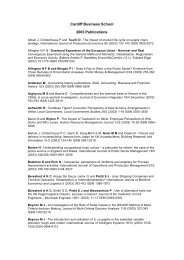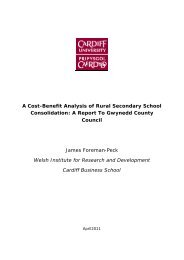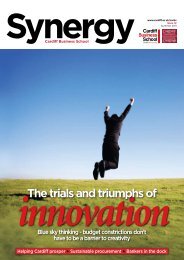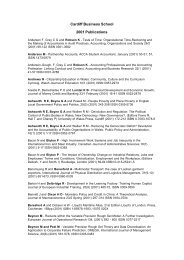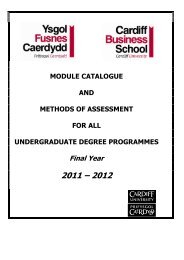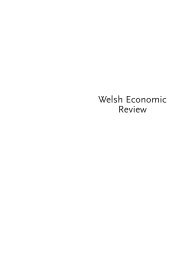Revisiting the Great Moderation using the Method of Indirect Inference
Revisiting the Great Moderation using the Method of Indirect Inference
Revisiting the Great Moderation using the Method of Indirect Inference
Create successful ePaper yourself
Turn your PDF publications into a flip-book with our unique Google optimized e-Paper software.
Ireland's Taylor Rule can in principle be distinguished from <strong>the</strong> Optimal Timeless Rule<br />
via his restriction on <strong>the</strong> rule's error. As noted earlier we cannot apply this restriction<br />
within our framework here so that Ireland's Taylor Rule in its unrestricted form here only<br />
diers materially from <strong>the</strong> Optimal Timeless Rule in <strong>the</strong> interpretation <strong>of</strong> <strong>the</strong> error. But<br />
from a welfare viewpoint it makes little dierence whe<strong>the</strong>r <strong>the</strong> cause <strong>of</strong> <strong>the</strong> policy error<br />
is excessive target variation or excessively variable mistakes in policy setting; <strong>the</strong> former<br />
can be seen as a type <strong>of</strong> policy mistake. Thus both versions <strong>of</strong> <strong>the</strong> rule imply that what<br />
changed in it between <strong>the</strong> two subperiods was <strong>the</strong> policy error.<br />
It might be argued that <strong>the</strong> success <strong>of</strong> Ireland's rule reveals that a type <strong>of</strong> Taylor Rule<br />
does after all t <strong>the</strong> data well. This would be true. But in <strong>the</strong> context <strong>of</strong> <strong>the</strong> debate over<br />
<strong>the</strong> cause <strong>of</strong> <strong>the</strong> <strong>Great</strong> <strong>Moderation</strong> it is to be rmly distinguished from what we call <strong>the</strong><br />
`standard Taylor Rule' under which shifts in <strong>the</strong> rule's parameters are regarded as <strong>the</strong><br />
cause. In Ireland's rule <strong>the</strong>re are no such shifts and as we have seen <strong>the</strong> behaviour under<br />
it is essentially identical to that under <strong>the</strong> Optimal Timeless Rule setting.<br />
6.2 Simulated Annealing and model tests with nal parameter<br />
selection<br />
The above results based on calibration thus suggest that <strong>the</strong> Optimal Timeless Rule,<br />
when embedded in our IS-Phillips curves model, outperforms testable Taylor Rules <strong>of</strong><br />
<strong>the</strong> standard sort in representing <strong>the</strong> Fed's monetary behaviour since 1972.<br />
In both<br />
<strong>the</strong> <strong>Great</strong> Acceleration and <strong>the</strong> <strong>Great</strong> <strong>Moderation</strong> <strong>the</strong> only model version that fails to be<br />
strongly rejected is <strong>the</strong> one in which <strong>the</strong> optimal timeless policy was eectively operating.<br />
However, xing model parameters in such a way is a excessively strong assumption in<br />
terms <strong>of</strong> testing and comparing DSGE models. This is because <strong>the</strong> numerical values <strong>of</strong> a<br />
model's parameters could in principle be calibrated anywhere within a range permitted<br />
by <strong>the</strong> model's <strong>the</strong>oretical structure, so that a model rejected with one set <strong>of</strong> assumed<br />
parameters may not be rejected with ano<strong>the</strong>r. Going back to what we have just tested,<br />
29



